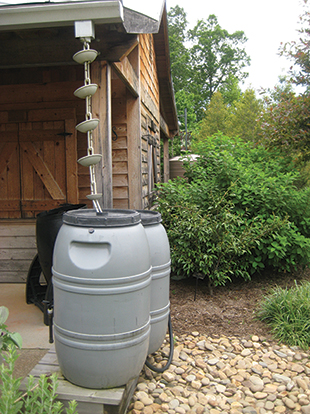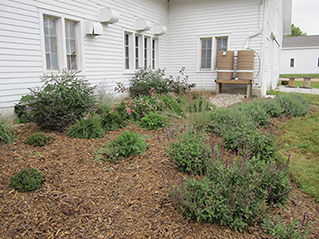G2220
Stormwater Management:
Rainwater Harvesting with Rain Barrels
This NebGuide provides information on the use of rain barrels for collecting and temporarily storing rainwater from rooftops; non-potable uses of collected rainwater; and rain barrel components, installation, and maintenance.
Kelly A. Feehan, Extension Horticulture Educator
Katie A. Pekarek, Extension Stormwater Educator
David P. Shelton, Extension Agricultural Engineer
Steven N. Rodie, Landscape Horticulture Specialist
Thomas G. Franti, Surface Water Management Engineer
- Benefits of Using Rain Barrels
- Estimating Rainwater Amounts from a Rooftop
- Rain Barrel Containers
- Rain Barrel Components
- Rain Barrel Installation
- Rain Barrel Water Quality and Safety
- Rain Barrel Limitations and Issues
- Rain Barrel Maintenance
- Summary
- Resources
|
Rainwater is often treated as a nuisance or waste product. Rooftops, streets, paved areas, and landscapes are designed to move stormwater (rainwater and snowmelt) away as quickly as possible. In towns and cities, stormwater is directed into storm drains and underground pipes through which it flows directly to streams, rivers, and lakes, taking sediment, fertilizer, oil, litter, and other pollutants with it. In nearly all cases, stormwater runoff is not cleaned at a water treatment facility before being discharged into waterways.
Rainwater harvesting treats rainwater as a valuable resource to be collected and used, rather than conveyed away. Rain barrels, generally 50- to 100-gallon containers, are a traditional method of rainwater harvesting. They are typically used to collect and temporarily store rainwater from rooftops using the gutter and downspout system (Figure 1). Collected rainwater is most often used to water landscape or container plants, or diverted to planted areas for infiltration into the soil.
Benefits of Using Rain Barrels
Rain barrels, especially when used along with other rainwater harvesting methods, provide many benefits that lead to conservation and protection of water resources. While rain barrels are limited in the amount of rainwater that can be collected, they are a good introduction to rainwater harvesting. Beyond their direct benefits, they help raise public awareness of stormwater issues.
Collected rainwater can be an alternative water source to supplement irrigation of trees, shrubs, and flowers, thus conserving municipal drinking water or residential well water. Rainwater harvesting reduces the volume of stormwater runoff and associated pollutants flowing from a property, which helps reduce the amount of pollutants entering streams, rivers, and lakes. See NebGuide Stormwater Management: Rainwater Harvesting in Residential-Scale Landscapes (G2148) for information on other rainwater harvesting methods.
Estimating Rainwater Amounts from a Rooftop
As a rule, 0.6 gallons of water will fall on one square foot (sq ft) of roof area during a one-inch rain. This amount will vary somewhat with the configuration of the roof, wind conditions, and other factors. One inch is often used as the rainfall amount for design or calculation purposes since approximately 90 percent of all rain events in Nebraska are one inch or less.
To estimate the amount of rainwater that can be harvested from a rooftop:
- Determine the square footage of the roof area. For example: From the ground, measure the length and width of the house, then estimate the width of the roof overhang (often about two feet). Add two times the width of the roof overhang to the measured length and width of the house to obtain the approximate length and width of the roof. Multiply the roof length by the roof width for an estimate of the square footage of the roof. (If the house is not rectangular, use this process to estimate the square footage of individual sections then add together the square footage of the sections to estimate total square footage.)
- Determine total volume of runoff. Multiply the square footage of the roof area by the rainfall amount in inches; then multiply by 0.623 (a conversion factor to convert inches of rainfall to gallons per square foot). For example: A typical 1,200 sq ft roof could yield approximately 750 gallons of water from a one-inch rain.
Roof Collection Area (sq ft) × Rainfall (inches) × 0.623 = Volume (gallons)
1,200 sq ft × 1 inch × 0.623 = 750 gallons
- Determine the volume of rainwater that could flow from the downspout to which the rain barrel will be connected by estimating the square footage of roof area that drains to that downspout. Many roofs have dormers as well as multiple roof angles and associated downspouts that may complicate this estimate. To enhance accuracy, view the roof from a variety of points on the ground, or reference an aerial photograph (for example in Google Maps or a county tax assessor database) to help clarify specific roof areas.
For example: If one-fourth of a typical 1,200 sq ft roof (300 sq ft) drained to one downspout, approximately 185 gallons of rainwater could potentially flow into a rain barrel connected to that downspout during a one-inch rain. In this situation, a typical 55-gallon container will overflow due to its limited capacity. Capacity will be further reduced if it still contains water from a previous storm. Overflow water must specifically be directed into additional rain barrels or to a designated landscape area or other permeable surface away from building foundations.
Rain Barrel Containers
Rain barrels are commercially available from home and garden stores, hardware stores, and other retailers. They can also be constructed from a variety of existing containers including heavy duty plastic garbage cans, recycled oak whiskey barrels, and fiberglass or concrete containers. Commercial or recycled plastic barrels may be best. These are lightweight, long lasting, and will not rust. For home-constructed barrels, select a food-grade container or one that did not hold toxic materials or harsh chemicals. Do not use a container that contained oil or a pesticide (e.g., herbicide, insecticide).
Rain barrel containers should be dark-colored or opaque. Light colored barrels allow in sunlight which encourages algae growth. If white or light colored barrels are used, paint them a darker color.
When selecting a container for rainwater collection, choose the largest size feasible for the site. Consider the potential amount of rainwater that could be collected and the planned uses for the water. Containers larger than 100 gallons are referred to as cisterns and may be feasible for some residential locations. Another option is to link two or more rain barrels together using common barrel sizes and components to provide greater storage capacity.
Rain Barrel Components
Each storage container needs a cover, screen/filter, inlet, outlet, and overflow outlet. Covers (solid or screened) are needed to keep out mosquitoes, tree leaves, other debris, pets, and wildlife. Secure covers are important to prevent children from crawling inside. Removable covers are convenient for cleaning inside the barrel.
The inlet is where water is directed into the barrel. If the cover is solid, the inlet opening can be small enough to insert a downspout extension to move water from the downspout to the inlet (Figure 2). Filtering such as with a screen is needed to reduce the amount of debris entering the barrel. Filters can be on the gutter, at the inlet to the barrel, or at both locations. If the inlet or the majority of the top is open but screened, the container may be placed directly beneath the shortened downspout (Figure 3).
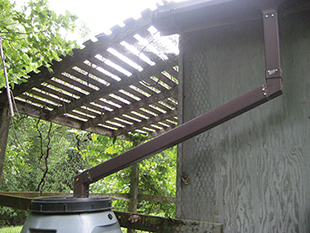 |
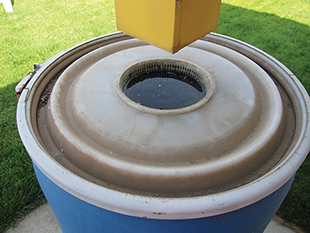 |
|
Figure 2. Downspout extension directs rainwater into the rain barrel. |
Figure 3. Barrel placed beneath the downspout. Excess water may overflow more readily out of this type of opening. |
The outlet is typically a hose bibb (spigot, faucet) attached near the base of the container (Figure 4). Having the outlet as close to the bottom as possible reduces the amount of water remaining in the container after emptying, and may slightly increase the amount of water pressure available to disburse the stored water for use.
An overflow outlet is critical for carrying excess water away from the barrel to prevent water pooling near a building foundation. The outlet is an opening near the top of the barrel to which a flexible hose or pipe (Figure 5) is connected. The opening should be approximately the same size as the downspout emptying into the barrel to allow for adequate overflow capacity during heavy rain events.
When overflow occurs, a nearly solid cover on the barrel may help force excess water into the overflow pipe or hose so that much of it is directed away from the barrel to a designated area. An open or screened cover can allow excess water to flow out of the top of the barrel, as well as through the overflow outlet, and possibly pool around the container or building. Rain barrels should be emptied between rain events to maximize the amount that is collected for use, and to decrease overflow events.
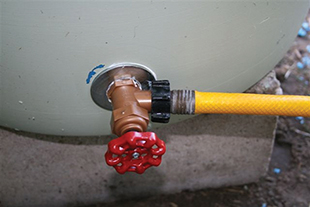 |
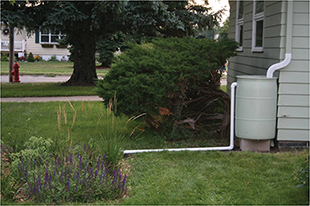 |
|
Figure 4. Rain barrel water outlet — a hose bibb with hose attached for dispersing water. |
Figure 5. PVC extension connected to overflow to direct water away from barrel. |
Rain Barrel Installation
Properly install rain barrels for safety, to avoid water pooling around the barrel, and to aid in disbursing water from the container. When selecting a site, consider downspout location, how and where the collected water will be used, and how and where overflow water will be directed.
Locate rain barrels on a flat, secure surface. A full barrel is heavy. One gallon of water weighs almost 8.5 lb and a 55-gallon container weighs over 450 lb when full of water.
Most rain barrels are elevated on a short, secure platform (Figure 6) to provide clearance for attaching a hose, to place a watering can beneath the outlet, or to facilitate connecting multiple barrels for additional storage capacity. Rain barrels should be anchored to a building or other secure object for increased stability and safety.
 |
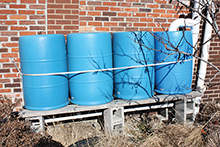 |
Figure 6. (Left) Barrels securely elevated and anchored with a sturdy platform, straps, and connection to the building for safety. (Right) Barrels poorly supported on wood planks and concrete blocks and tied with a single rope around all barrels. This is not as strong or secure as using a single strap on each barrel. |
|
To install the rain barrel, the downspout is typically cut at the height needed to place the rain barrel beneath it. The component used to convey rainwater from the cut end of the downspout into the rain barrel (for example, an elbow or flexible downspout extension) is then securely attached to the downspout with screws and directed or inserted into the rain barrel.
|
The overflow pipe or flexible hose is attached to the overflow opening and positioned to direct water away from the barrel. To increase the amount of rainwater harvested and used, direct the overflow water to additional linked rain barrels, and/or to planted areas such as a rain garden (Figure 7). If a linked barrel system is used, the last barrel still needs to be equipped to handle overflow.
Rain Barrel Water Quality and Safety
Rainwater collected in rain barrels is recommended for non-potable (water that is not drinking water quality and is not safe for consumption) uses, such as watering ornamental plants. Municipal drinking water often can contain sodium or other chemicals that can lead to plant health issues, while rainwater is free of these chemicals.
Rainwater from rain barrels is not recommended for watering fruit and vegetable gardens. It is not suitable for humans or pets to consume, or for uses that include direct body or food contact, such as in a child’s swimming pool or for bathing, hair washing, or washing produce.
Concerns with rain barrel water safety stem primarily from bird droppings and animal waste deposited on rooftops. Bacteria and other disease-causing organisms could be picked up by rainwater flowing over rooftops.
Another safety concern are chemicals in roof runoff that could come from asphalt roofing, redwood or cedar shakes, treated wood shingles, roofing materials containing asbestos, lead solder or lead-based paints, metals such as zinc from galvanized flashing, moss killers, and other sources. Deposition of industrial pollutants and/or herbicide drift on rooftops also may be a potential issue depending on where you live.
While bacteria and chemical deposition are not considered major concerns for non-potable uses of collected rainwater, they provide sufficient reasons not to use rain barrel water for potable uses. Specialized filtering and treatment are required for rainwater to be suitable for drinking, cooking, bathing, or other direct human contact.
Rain Barrel Limitations and Issues
A limitation of rain barrels is their small size in comparison to the potential amount of rainfall that could be collected from even a portion of a rooftop. Again, select the largest container feasible and/or link two or more containers together. Direct overflow water to a planted area, ideally a rain garden, to increase the amount and benefits of rainwater harvested and used. Avoid directing overflow to an impermeable surface such as a driveway or sidewalk where it could end up in a storm drain, and do not direct it toward a building foundation, neighboring property, or any component of an on-site septic system.
Another limitation may be low water pressure. Water flow and pressure from a rain barrel will be much less than from an outdoor spigot, generally making it ineffective to use sprinklers for water distribution. Soaker hoses that require very low pressure (some are sold specifically for use with rain barrels) may work. Using taller containers and elevating them on a platform will slightly increase water pressure. The simplest and best distribution method is often with a watering can.
Algae growth and mosquito breeding are issues that may arise with rain barrels. Both can be prevented. Algae growth is promoted mainly by nutrients, light, and warm water temperature. Mosquito breeding is promoted by the use of open barrels and allowing collected water to become stagnant.
To reduce algae growth:
- Limit nutrient build-up in the barrel by reducing the amount of sediment and plant debris entering the barrel. These are sources of nutrients like phosphorous and nitrogen that promote algae. Clean roof gutters at least annually. If hosing out the roof gutter, remove the rain barrel before cleaning. Consider installing gutter screens along with using screens/filters before the barrel inlet.
- Clean the barrel at least once a year to remove sediment.
- Use dark-colored, painted, or opaque barrels to limit light.
- Place rain barrels in a shady location when possible.
Using a closed barrel system and tight fitting connections, and covering openings with fine mesh screen is the most effective way to prevent mosquitoes from entering. Mosquitoes require 7 to 10 days of stagnant water to develop from egg to adult. Using the rainwater within this time can prevent mosquito development. Be aware, though, that even after emptying a rain barrel, two to three inches of water can remain in the bottom which may allow mosquito development if they gain access to the barrel.
Rain Barrel Maintenance
A properly selected and installed rain barrel requires some maintenance. A filter or screen that is part of the barrel should be cleaned regularly, ideally after each rainfall. Periodically check the entire rain barrel system for loose fittings, leaky connections, torn or clogged screens or filters, cracks, and build-up of sediment or other debris on the inside bottom of the barrel.
At season-end, clean the inside of the barrel. Hose out debris, then rinse the inside of the barrel. Use a solution of one-eighth cup of chlorine bleach mixed into five gallons of water. Read and follow label directions and wear appropriate protective gear like goggles and rubber gloves. Other cleaning solutions include one-quarter cup each of castile soap and vinegar or lemon juice mixed into five gallons of water. Follow by rinsing with clean water.
During winter, disconnect the downspout from the rain barrel to protect components from freezing water and to avoid water backing up into downspouts or overflowing around building foundations. Store the barrel in a shed or garage if possible; or upside down if stored outdoors. Reattach downspouts to the gutter system with screws so precipitation during winter does not seep into the building or damage the foundation. Some rain barrel users have two downspouts; a shortened one that directs water to the rain barrel during use, and a longer one that is used when the rain barrel is removed during freezing weather.
Summary
Collecting rainwater with rain barrels is an introduction to rainwater harvesting. The benefits of correctly installing rain barrels and directing overflow water to additional rainwater harvesting methods such as a rain garden include:
- Conservation of drinking water by reducing the amount of domestic water used for non-potable needs like plant irrigation.
- Decreasing the volume and velocity of stormwater and associated pollutants that run off of a property.
- Increased soil moisture for reduced irrigation requirements as well as enhanced plant vigor, hardiness, and drought tolerance.
Resources
UNL Water Website: http://water.unl.edu
Related UNL Extension publications in the Stormwater Management Series available online at ianrpubs.unl.edu include:
- Rainwater Harvesting in Residential-Scale Landscapes (G2148)
- Rain Garden Design for Homeowners (G1758)
- Plant Selection for Rain Gardens in Nebraska (G1759)
- Installing Rain Gardens in Your Yard (G1760)
- Water Pollution and Our Own Yards (G1848)
- Landscape Water Conservation (G1859)
- Rain Garden Design Site and Selection Guide (EC1262)
- Nebraska Bioretention and Rain Garden Plants Guide (EC1261)
- Stormwater Management on Residential Lots (EC707)
This publication has been peer reviewed.
Visit the University of Nebraska–Lincoln Extension Publications website for more publications.
Index: Water Management
Water Quality
Issued January 2014
